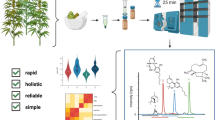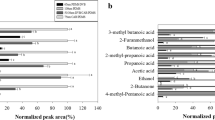Abstract
A method was validated for the determination of ochratoxin A (OTA) in soluble and green coffee. Performance parameters evaluated included selectivity, accuracy, intermediate precision, linearity, limit of detection, limit of quantitation, and ruggedness. The method was found to be selective for OTA in both matrices tested. Recovery rates from soluble coffee samples ranged from 73.5 to 91.2%, and from green coffee samples from 68.7 to 84.5%. The intermediate precision (RSDr) was between 9.1 and 9.4% for soluble coffee and between 14.3 and 15.5% for green coffee analysis. The linearity of the standard calibration curve (r2) was <0.999 for OTA levels of 1.0–20.0 μg/kg in coffee samples. The limit of detection was determined to be 0.01 ng of OTA on column, while the limit of quantitation was found to be 0.03 ng on column. The limit of quantitation is equivalent to 0.6 μg/kg in soluble coffee samples and 0.3 μg/kg in green coffee samples. The results of the ruggedness trial showed two factors are critical for soluble coffee analysis: the extraction method, and the flow rate of the mobile phase. For green coffee analysis two critical factors detected were the extraction method and the storage temperature of the immunoaffinity column.
Five samples of soluble coffee and 42 of green coffee were analysed using the validated method. All soluble coffee samples contained OTA at levels that ranged from 8.4 to 13.9 μg/kg. Six of the 42 green coffee samples analysed (14.3%) contained OTA at levels ranging from 0.9 to 19.4 μg/kg. The validated method can be used to monitor OTA levels in Colombian coffee for export or for local consumption.
Similar content being viewed by others
References
Leeson S, Diaz GJ, Summers JD (1995) Ochratoxins. In:Poultry Metabolic Disorders and Mycotoxins. University Books, Guelph, pp. 227–248.
IARC (1993)Some Naturally Occurring Substances: Food Items and Constituents, Heterocyclic Aromatic Amines and Mycotoxins. IARC Monographs on the Evaluation of Carcinogenic Risks to Humans, vol. 56, International Agency for Research on Cancer, Lyon, pp. 489–521.
WHO, 2001,Safety Evaluation of Certain Mycotoxins in Food. Food Additives Series: 47. World Health Organization, Geneva, pp. 281–415.
Shotwell OL, Hesseltine CW, Goulden ML (1969) Note on the natural occurrence of ochratoxin A. J AOAC 52: 81–83.
Krogh P (1987) Ochratoxins in food. In: P Krogh (ed)Mycotoxins in Food. Academic Press, London, pp. 97–121.
Levy CP, Trenck HL, Mohr HK (1974) Study of the occurrence of ochratoxin A in green coffee beans. J AOAC 57: 866–871.
Studer-Rohr I, Dietrich DR, Schlatter J, Schaltter C (1995) The occurrence of ochratoxin A in coffee. Food Chem Toxicol 33: 341–355.
Pittet A, Tornare D, Huggett A, Viani R (1996) Liquid Chromatographic determination of ochratoxin A in pure and adulterated soluble coffee using an immunoaffinity column cleanup procedure. J Agric Food Chem 44: 3564–3569.
Duris D. (2002) Coffee and ochratoxin contamination.Food Safety Management in Developing Countries, Proceedings of the International Workshop, edited by Hanak E, Boutrif E, Fabre P, Pineiro M. CIRAD-FAO, Montpellier, pp. 1–5.
Trucksess MW, Giler J, Young K, White KD, Page S (1999) Determination and survey of ochratoxin A in wheat, barley, and coffee — 1997. J AOAC Int 81: 85–89.
Pittet A, Royer D (2002) Rapid, low cost thin layer Chromatographic screening method for the detection of ochratoxin A in green coffee at a control level of 10 μg/kg. J Agric Food Chem 50: 243–247.
Santos EA, Vargas EA (2002) Immunoaffinity column clean-up and thinlayer chromatography for determination of ochratoxin A in green coffee. Food Addit Contam 19: 447–458.
AOAC INTERNATIONAL (1998)Natural toxins. Official Methods of Analysis, 16th edn., AOAC International, Gaithersburg, pp. 39–40.
Horwitz (2002) AOAC requirements for single laboratory validation of chemical methods. Draft 2002-11-07.
EURACHEM (1998)The Fitness for Purpose of Analytical Methods.A Laboratory Guide to Method Validation and Related Topics. EURACHEM Working Group Teddington, Middlesex, UK.
CITAC - EURACHEM (2002)Guide to Quality in Analytical Chemistry - An Aid to Accreditation. The Cooperation on International Traceability in Analytical Chemistry and EURACHEM (A Focus for Analytical Chemistry in Europe).
Youden WJ, Steiner EH (1975) Statistical Manual of the Association of Official Analytical Chemists. AOAC International, Gaithersburg, MD, USA, pp. 50–55.
Garfield FM, Klesta E, Hirsh J. (2000) Quality Assurance Principles for Analytical Laboratories, 3rd edn. AOAC International, Gaithersburg.
CAST (2003) Mycotoxins - Risks in Plant, Animal, and Human Systems. Council for Agricultural Science and Technology, Ames, Iowa, USA.
Author information
Authors and Affiliations
Corresponding author
Rights and permissions
About this article
Cite this article
Diaz, G.J., Ariza, D. & Perilla, N.S. Method validation for the determination of ochratoxin A in green and soluble coffee by immunoaffinity column cleanup and liquid chromatography. Mycotox Res 20, 59–67 (2004). https://doi.org/10.1007/BF02946736
Received:
Accepted:
Issue Date:
DOI: https://doi.org/10.1007/BF02946736




